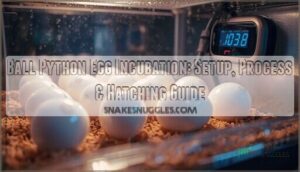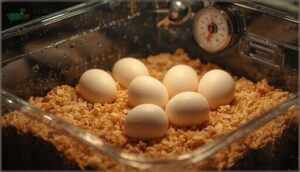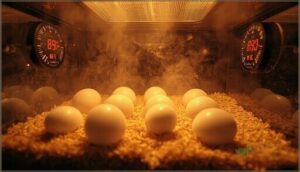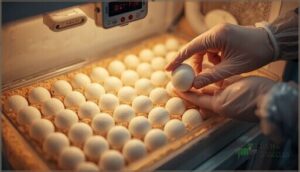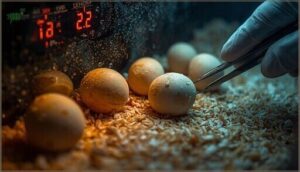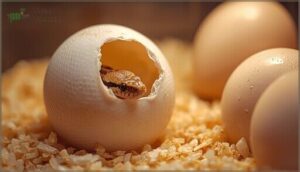This site is supported by our readers. We may earn a commission, at no cost to you, if you purchase through links.
A single degree too high or too low can mean the difference between healthy hatchlings and developmental failures. Ball python egg incubation demands precision—you’re basically creating an artificial womb where temperature, humidity, and air exchange must remain stable for nearly two months.
Most breeding failures trace back to inconsistent incubation conditions rather than genetic issues. The good news? With proper equipment and methodical monitoring, you can maintain the exact environment these eggs need.
Success starts with understanding what tools you’ll need, how to calibrate your setup before eggs arrive, and which parameters matter most during each stage of development.
Table Of Contents
- Key Takeaways
- Essential Supplies for Ball Python Egg Incubation
- Setting Up The Incubation Environment
- Incubation Process Step-by-Step
- Troubleshooting and Preventing Incubation Issues
- Hatching and Post-Incubation Care
- Frequently Asked Questions (FAQs)
- Can I let my ball python incubate her own eggs?
- What temperature do ball python eggs hatch at?
- How long do Ball Python Eggs incubate?
- How do ball pythons incubate?
- What temperature do you incubate Ball Python eggs?
- Can a ball python incubate her own eggs?
- How long do you incubate ball python eggs?
- What humidity should ball python eggs be incubated at?
- Can you incubate ball python eggs at 87 degrees?
- What can I use to incubate snake eggs?
- Conclusion
Key Takeaways
- Ball python egg incubation requires maintaining precise temperature (88-90°F) and humidity (90-100%) for 55-60 days, with most breeding failures stemming from inconsistent conditions rather than genetic issues.
- Your setup needs three core components working together: a reliable incubator with digital controls, vermiculite substrate mixed 1:1 with water by volume, and redundant monitoring systems to catch equipment failures before they damage the clutch.
- Never rotate eggs after initial placement and mark the top with a non-toxic dot before transfer, since flipping disrupts embryo development and can cause complete failure even in otherwise healthy eggs.
- Maternal incubation doesn’t work reliably in captivity due to environmental fluctuations, so you’ll need a dedicated incubator with external probes measuring conditions at egg level rather than trusting the snake to maintain proper warmth.
Essential Supplies for Ball Python Egg Incubation
Getting your incubation setup right starts with gathering the right equipment before your female lays her clutch. You’ll need three core components: a reliable incubator, appropriate substrate material, and accurate monitoring tools.
Each piece plays a specific role in maintaining the stable environment your eggs need to develop properly over the next 55-60 days.
Choosing The Right Incubator
An incubator that holds 29 to 32 degrees Celsius will protect your Ball Python eggs from dangerous fluctuations. You’ll want a digital climate controller with external probes to monitor conditions at egg level, not just at the walls. Look for insulated units with transparent lids so you can check your clutch without disrupting temperature or humidity. Safety alarms catch problems before embryos suffer.
Maintaining a stable environment is vital for successful incubation, which involves careful methodological rigor to guarantee the health of the embryos.
Recommended Substrates and Containers
Once you’ve selected your incubator, you need substrate and containers that create the right microclimate for egg incubation. Vermiculite stands out because it holds 200-300% of its weight in water, maintaining 90% humidity for the full 55-60 day period. Mix one part vermiculite to one part water by volume.
Your container choices matter just as much:
- Delrin boxes withstand 40-50°C without warping and accommodate 12-24 eggs in a 32-quart size
- Polystyrene foam boxes provide excellent insulation with an R-value of 4.0 per inch
- Translucent walls let you inspect eggs without opening the lid and losing humidity
- Airtight seals minimize moisture loss to under 5% weekly
Perlite works as an alternative substrate, conducting heat evenly and reducing temperature gradients by 2°C. It’s lightweight, so it won’t compact around your eggs. HatchRite offers a pre-mixed option that eliminates measuring errors and achieves 88% hatch rates in trials.
Substrate moisture should feel damp but never pooled—think wrung-out sponge. Your eggs sit one-third to one-half buried, allowing air exchange while preventing desiccation. The pH-neutral properties of vermiculite at 7.0 prevent shell degradation throughout incubation.
Monitoring Tools for Temperature and Humidity
Your containers and substrate won’t mean much if you can’t measure what’s happening inside. Digital thermometers with external temperature probes give you 0.1°C resolution—critical when 88-92°F is your target range. Place probes at egg level, not in the air above, where readings run 1-2°C hotter than reality.
Hygrometer calibration matters more than most keepers realize. Standalone humidity sensors drift ±3-5% over weeks, so verify them monthly against saturated salt solutions. Sodium chloride creates 75% RH at 25°C—your standard for accuracy.
Run at least two independent systems. When your primary thermometer fails at day forty, redundancy saves your clutch. Temperature control methods depend on accurate measurement—one miscalibrated sensor can shift your entire incubation temperature by 2°C without you noticing until collapse rates tell the story.
Redundant monitoring systems prevent catastrophic losses when a single miscalibrated sensor silently shifts incubation temperature by 2°C
| Device Type | Key Benefit | Practical Application |
|---|---|---|
| Digital thermometer-hygrometer combo | Tracks both parameters simultaneously | Detects correlations between temperature control and humidity levels |
| Bluetooth-enabled monitor | Real-time alerts to your phone | Catches ±1°C deviations during power interruptions |
| Data loggers | Records every fluctuation | Reviews incubation temperature patterns after hatch failures |
| Infrared thermometer | Instant surface readings | Identifies cold spots across multiple egg boxes |
| Battery backup alarm | Sounds when thresholds breach | Protects against catastrophic humidity management failures |
Setting Up The Incubation Environment
Setting up your incubation environment correctly determines whether your eggs develop properly or fail midway through the process. You’ll need to prepare three key components before your female lays her clutch: the nesting box that holds the eggs, the precise temperature and humidity settings, and the physical location of your incubator.
Each element works together to create the stable conditions ball python eggs require for those critical 55-60 days.
Preparing The Nesting Box or Egg Box
Your nesting box functions as the climate-controlled nursery where your Ball Python eggs will spend the next two months. Choose a sealable plastic tub measuring 6–8 inches tall with smooth interior surfaces to prevent egg damage.
Fill it with 2–3 inches of pre-moistened vermiculite or sterilized coco coir, which holds humidity without promoting mold. Label each egg box clearly to track individual clutches.
Calibrating Temperature and Humidity
Before placing your eggs inside, you’ll need to stabilize your incubator’s environment to species-specific targets. Set temperature control between 88–90°F using a reptile thermometer positioned at egg level, checking readings every 6–12 hours.
Maintain humidity sensors near 90–100% with damp substrate adjustments. Calibrate your hygrometer against a trusted device, then seal gaps to prevent environmental stability drift during egg incubation.
Ideal Placement of Incubator
Beyond ambient room temperature, your incubator’s location determines developmental success. Position the unit on a stable surface away from direct sunlight, drafts, and high-traffic zones that cause vibrations.
Verify proximity to a dedicated power outlet with surge protection, and maintain clear access for monitoring humidity control adjustments.
A temperature-stable room with consistent ventilation management prevents the environmental swings that compromise Ball Python egg incubation.
Incubation Process Step-by-Step
Once your incubator is running at the correct temperature and humidity, you’re ready to handle the eggs and begin the actual incubation period. This phase requires careful attention to placement, consistent environmental control, and regular monitoring to guarantee healthy development.
The following steps will walk you through proper egg handling, maintaining stable conditions, and tracking progress throughout the 55-60 day incubation window.
Proper Egg Placement and Orientation
Once your incubator is running, you’ll transfer eggs carefully to maintain their original position. Mark the top of each egg with a non-toxic dot before moving it—this ensures you won’t accidentally flip or rotate it later.
Here’s how to set up each egg properly:
- Egg Orientation: Place eggs with the widest end up to support gas exchange and air cell alignment.
- Vertical Placement: Keep eggs in a stable upright position throughout incubation to protect embryo development.
- Substrate Depth: Bury each egg one-third to one-half deep in vermiculite for thermal stability.
- Embryo Protection: Never rotate eggs after placement, as this can disrupt the developing embryo.
- Incubation Stability: Use individual compartments or small containers to prevent contact damage between eggs.
Proper egg hatching techniques start with careful handling—wear clean gloves and minimize contact. Your reptile egg incubation success depends on maintaining consistent temperature control and humidity levels from day one, so double-check your incubator settings before placing eggs inside.
Maintaining Stable Conditions Throughout Incubation
Your eggs need rock-solid environmental consistency over the next 55 to 60 days.
Temperature control between 88°F and 92°F isn’t negotiable—digital thermostats with external probes give you precision that built-in incubator sensors can’t match.
Keep humidity management near 90-100% by monitoring substrate moisture daily. Use continuous data logging to catch drifts before they become disasters, and recalibrate your sensors weekly for accuracy.
Monitoring Development and Candling Eggs
Candling reveals what’s happening beneath the shell. Use a focused, low-intensity light in a dark room to check embryo development every 5-7 days without transferring excess heat.
Look for these indicators of healthy vessel growth:
- Visible blood vessel networks appearing by day 7-14
- Fluid egg contents without excessive bubbling
- Steady growth patterns throughout incubation
Translucent eggs with no vascular development signal infertility.
Troubleshooting and Preventing Incubation Issues
Even with careful preparation, incubation doesn’t always go according to plan. Temperature swings, humidity drops, and egg abnormalities can threaten your clutch if you don’t catch them early.
You’ll need to recognize warning signs quickly and know exactly how to respond when conditions drift off target.
Identifying Signs of Incubation Problems
You’ll know something’s wrong when a foul smell hits you or visible mold appears on the shell—clear signs of egg contamination or fungal infections.
Candling reveals embryo development issues: no movement, shrinking membranes, or collapsing eggs point to incubation failure.
Uneven weight loss signals humidity problems in your incubator. These warning signs demand immediate attention to save the clutch.
Adjusting for Temperature or Humidity Fluctuations
When your readings drift off target, fast action prevents embryo stress. Fluctuations beyond 1°C or 5% humidity shift metabolic rates and water loss, threatening your clutch.
- Run a secondary thermometer alongside your incubator’s built-in sensor to catch drift early
- Add a damp sponge inside the chamber when humidity drops unexpectedly
- Move your incubator away from windows or vents that create temperature swings
- Log readings twice daily to spot trends before they escalate
- Keep a backup incubator ready for emergency transfers during equipment failure
Handling Infertile or Problematic Eggs
Once you’ve stabilized conditions, turn your focus to identifying bad eggs before they threaten the clutch. Infertile eggs stay firm or gelatinous rather than developing visible veins by week two—clear egg assessment prevents fungal spread.
Remove cloudy, moldy, or foul-smelling eggs promptly using clean tools to protect viable siblings. Document each removal to improve your reptile breeding approach and boost hatch rate optimization in future cycles.
Hatching and Post-Incubation Care
After 55 to 60 days of careful incubation, your ball python eggs will begin the hatching process. You’ll need to recognize the signs that hatching is underway and decide whether intervention is necessary.
This section covers the hatching timeline, egg cutting techniques, and the immediate care your hatchlings need once they emerge.
Recognizing The Hatching Timeline and Signs
Patience during the incubation period pays off when you spot the first signs of hatching. Ball python eggs usually complete their 55 to 60-day incubation stages before hatchlings emerge.
Egg candling around day 40 reveals vascular patterns and movement, confirming healthy hatchling development.
You’ll notice eggs swelling or dimpling slightly as pipping approaches—clear indicators that your careful monitoring through each phase of egg incubation is about to succeed.
Egg Cutting: When and Why It’s Used
Once the first hatchling breaks through, you may consider egg cutting as an incubation rescue technique. This egg intervention aids clutch management when hatchling viability is at risk. Reptile egg incubation doesn’t always proceed perfectly, so understanding these incubation techniques helps.
Egg cutting fulfills specific purposes in your ball python incubator:
- Egg salvage when bacterial contamination threatens neighboring eggs
- Accessing viable embryos after misaligned humidity conditions
- Evaluating development when internal hatching issues prevent natural emergence
- Preventing mold spread during egg hatching complications
- Last-resort intervention under veterinary guidance for compromised clutches
Caring for Hatchlings After Emergence
Your neonates need immediate environmental stability once they’ve shed their egg tooth. Set up your hatchling care station with consistent warmth and minimal handling during those vulnerable first weeks—stress compounds quickly in ball python care. Monitor hydration through skin condition and eye clarity while you wait for feeding initiation.
| Care Element | Action Required | Warning Signs |
|---|---|---|
| Environmental Stability | Maintain steady temperature and humidity | Rapid fluctuations, cold spots |
| Hatchling Nutrition | Offer appropriately sized prey within days | Refusal beyond 2 weeks |
| Health Monitoring | Check hydration, shedding, activity daily | Sunken eyes, lethargy, wrinkled skin |
| Feeding Techniques | Present live or pre-killed options, remove uneaten food | Regurgitation, consistent refusal |
Schedule your reptile health and wellness check with a veterinarian experienced in breeding and raising hatchlings to catch early problems before they escalate into serious neonate care complications.
Frequently Asked Questions (FAQs)
Can I let my ball python incubate her own eggs?
Ball pythons don’t reliably incubate eggs in captivity. Maternal incubation usually fails due to environmental fluctuations and inconsistent nesting behavior.
You’ll need a dedicated incubator to achieve consistent hatch rates and protect egg survival.
What temperature do ball python eggs hatch at?
Despite what many assume, your incubator doesn’t need extreme heat. Ball python eggs hatch reliably at 88 to 90 degrees Fahrenheit—thermal stability matters more than hitting peak temperature for ideal hatch success.
How long do Ball Python Eggs incubate?
Your ball python eggs will incubate for 55 to 60 days under ideal temperature control and humidity levels. Proper incubation time depends on maintaining steady conditions throughout the egg development period.
How do ball pythons incubate?
Like clockwork, Python Breeding relies on three Incubation Methods: maternal incubation, where females coil around clutches maintaining temperature through muscle contractions, commercial incubators, or DIY setups controlling temperature, humidity, and Embryo Growth for ideal Egg Development and Hatchling Care.
What temperature do you incubate Ball Python eggs?
You’ll want to maintain incubator temperatures between 88 and 90 degrees Fahrenheit for ideal egg development. Most breeders target 89 to 90 degrees, staying within a ±1 to ±2 degree range for consistent hatching success.
Can a ball python incubate her own eggs?
Females frequently guard their clutches but won’t warm them effectively. Maternal incubation creates risks like temperature swings and egg retention problems.
You’ll need an incubator for successful natural hatching—don’t depend on female behavior alone.
How long do you incubate ball python eggs?
Your incubation period will usually run 55 to 60 days when you maintain temperatures between 88 and 92°F. Warmer conditions can shorten this timeline slightly, while cooler temps may extend it.
What humidity should ball python eggs be incubated at?
Your ball python eggs need humidity between 88 and 92 percent for ideal hatch success. Maintain around 90 percent to support proper egg moisture without inviting mold growth inside your incubation environment.
Can you incubate ball python eggs at 87 degrees?
Yes, 87°F falls within the acceptable range for ball python egg incubation. However, most experienced breeders prefer 88-90°F for ideal egg development and consistent breeding outcomes, as temperature control directly affects embryo viability and hatching success.
What can I use to incubate snake eggs?
You can use commercial incubators like a HovaBator, DIY incubators built from styrofoam, or dedicated reptile egg incubators.
Breeding boxes with heat sources and humidity control work well when paired with proper monitoring tools.
Conclusion
Think of ball python egg incubation as piloting a two-month flight—minor turbulence won’t crash the mission, but consistent navigation keeps everything on course. Your calibrated incubator, daily monitoring routine, and quick responses to fluctuations determine whether those eggs produce vigorous hatchlings or disappointing outcomes.
The process demands attention without obsession. Trust your equipment, document your parameters, and resist unnecessary intervention.
When you maintain that stability from placement through pipping, successful hatches become predictable rather than lucky.
- https://github.com/tugcekonuklar/msc-computer-science-notes/blob/main/research-methods/Home.md
- https://arxiv.org/html/2507.17948v2
- https://x.com/godofprompt/status/1990526288063324577
- https://www.linkedin.com/posts/bohdanlukianets_tasks-study-research-activity-7373377539521667072-UTEi
- https://www.sciencedirect.com/science/article/pii/S0749208123000268

